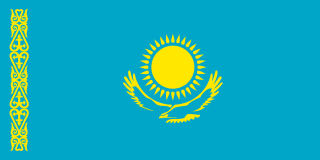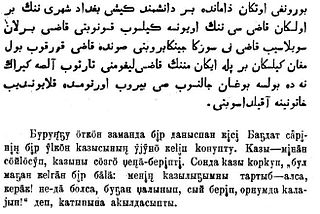
Kazakhstan, officially the Republic of Kazakhstan, is a landlocked country mostly in Central Asia, with a small part in Eastern Europe. It borders Russia to the north and west, China to the east, Kyrgyzstan to the southeast, Uzbekistan to the south, and Turkmenistan to the southwest, with a coastline along the Caspian Sea. Its capital is Astana, while the largest city and leading cultural and commercial hub is Almaty. Kazakhstan is the world's ninth-largest country by land area and the largest landlocked country. It has a population of 20 million and one of the lowest population densities in the world, at fewer than 6 people per square kilometre. Ethnic Kazakhs constitute a majority, while ethnic Russians form a significant minority. Officially secular, Kazakhstan is a Muslim-majority country, although ethnic Russians in the country form a sizeable Christian community.

Kazakhstan, the largest country fully within the Eurasian Steppe, has been a historical crossroads and home to numerous different peoples, states and empires throughout history. Throughout history, peoples on the territory of modern Kazakhstan had nomadic lifestyle, which developed and influenced Kazakh culture.

Kazakh or Qazaq is a Turkic language of the Kipchak branch spoken in Central Asia by Kazakhs. It is closely related to Nogai, Kyrgyz and Karakalpak. It is the official language of Kazakhstan and a significant minority language in the Ili Kazakh Autonomous Prefecture in Xinjiang, north-western China and in the Bayan-Ölgii Province of western Mongolia. The language is also spoken by many ethnic Kazakhs throughout the former Soviet Union, Germany, and Turkey.

Uzbek, formerly known as Turki, is a Karluk Turkic language spoken by Uzbeks. It is the official and national language of Uzbekistan and formally succeeded Chagatai, an earlier Karluk language also known as "Turki", as the literary language of Uzbekistan in the 1920s.
Khan is a historic Mongolic and Turkic title originating among nomadic tribes in the Central and Eastern Eurasian Steppe to refer to king. It first appears among the Rouran and then the Göktürks as a variant of khagan and implied a subordinate ruler. In the Seljuk Empire, it was the highest noble title, ranking above malik (king) and emir (prince). In the Mongol Empire it signified the ruler of a horde (ulus), while the ruler of all the Mongols was the khagan or great khan. The title subsequently declined in importance. During the Safavid and qajar dynasty it was the title of an army general high noble rank who ruling a province, and in Mughal India it was a high noble rank restricted to courtiers. After the downfall of the Mughals it was used promiscuously and became a surname. Khan and its female forms occur in many personal names, generally without any nobiliary of political relevance, although it remains a common part of noble names as well.

The Kazakhs are a Turkic ethnic group native to Central Asia and Eastern Europe, mainly Kazakhstan, but also parts of northern Uzbekistan and the border regions of Russia, as well as northwestern China and western Mongolia. The Kazakhs arose from the merging of the medieval tribes of Turkic and Mongolic origin in the 15th century.
Turkmen, Türkmen, Turkoman, or Turkman may refer to:

The national flag of Kazakhstan, also called the Kazakh flag, was adopted on 4 June 1992, replacing the flag of the Kazakh Soviet Socialist Republic. The flag was designed by Shaken Niyazbekov.

An official script is a writing system that is specifically designated to be official in the constitutions or other applicable laws of countries, states, and other jurisdictions. Akin to an official language, an official script is much rarer. It is used primarily where an official language is in practice written with two or more scripts. As, in these languages, use of script often has cultural or political connotations, proclamation of an official script is sometimes criticized as having a goal of influencing culture or politics or both. Desired effects also may include easing education, communication and some other aspects of life.
Turan is an ethnic and geographic term referring to certain areas and peoples of Central Asia.

Modern Kazakh culture is mainly characterized as a synthesis of Tengrian nomadic and Islamic and European elements. Nomadic elements derived from predecessors, such as the Huns, First Turkic Khaganate, Golden Horde and Kazakh Khanate. Nomadism largely shaped its peculiar music, clothing, jewelry and oral literature. Kazakh culture also seems to be strongly influenced by the nomadic Scythians.

Three alphabets are used to write Kazakh: the Cyrillic, Latin and Arabic scripts. The Cyrillic script is used in Kazakhstan and Mongolia. An October 2017 Presidential Decree in Kazakhstan ordered that the transition from Cyrillic to a Latin script be completed by 2031. The Arabic script is used in Saudi Arabia, Iran, Afghanistan, and parts of China.

The Kazakh Khanate, in eastern sources known as Ulus of the Kazakhs, Ulus of Jochi, Yurt of Urus, was a Kazakh state in Central Asia, successor of the Golden Horde existing from the 15th to the 19th century, centered on the eastern parts of the Desht-i Qipchaq.

The Eurasian Steppe, also called the Great Steppe or The Steppes, is the vast steppe ecoregion of Eurasia in the temperate grasslands, savannas and shrublands biome. It stretches through Hungary, Bulgaria, Romania, Moldova, Ukraine, southern Russia, Kazakhstan, Xinjiang, Mongolia and Manchuria, with one major exclave, the Pannonian steppe, located mostly in Hungary.

Kazakhstan–Russia relations are the bilateral foreign relations between Kazakhstan and the Russian Federation. Kazakhstan has an embassy in Moscow, a consulate-general in Saint Petersburg, Astrakhan and Omsk. Russia has an embassy in Astana and consulates in Almaty and Oral.
The braille alphabet used for the Kazakh language is based on Russian Braille, with several additional letters found in the print Kazakh alphabet.

Turkic history is the systematic documentation and study of events involving the Turkic peoples.

Uzbek literature refers to the literature produced and developed in the Republic of Uzbekistan with additional literary works contributed by the Afghanistan, Tajikistan, and Kyrgyzstan people of Central Asia. Influenced by Russian and Turkish literature, Uzbek is predominantly written in the Uzbek language with its roots in Chagatai language, one of the widely accessible languages in the region from 14th to 20th century. In Uzbek literature, Chagatai plays an important role as a reference point.
Kazakh diaspora is a term used to collectively to describe the ethnic or people of Kazakh descent who reside in outside of Kazakhstan across the world in various countries as a result of annexed territories and diasporic migration in the late 19th and early 20th centuries. It is estimated that more than four million Kazakhs live abroad. Although the Kazakh diaspora is usually a sparse one, particularly in Western Europe and United States, it retains ethnic enclaves within the countries of Turkey, Iran, and Afghanistan.












